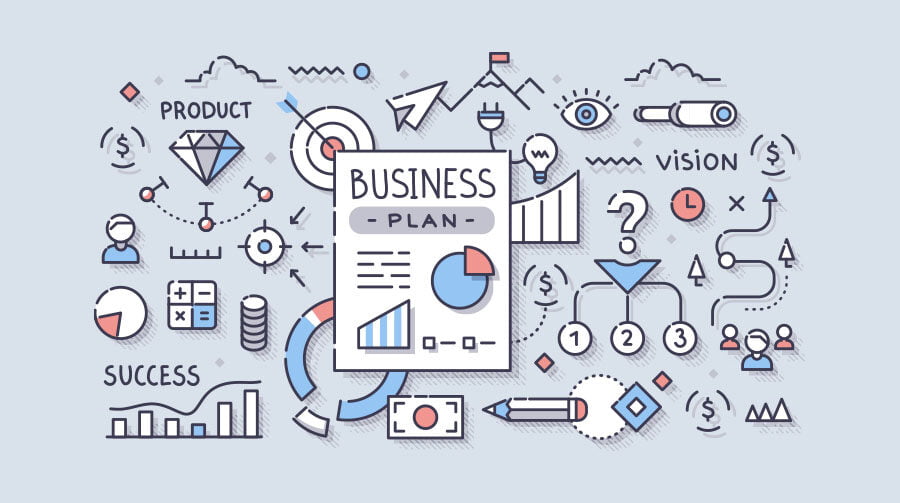Startup Business Plan: Success is in The Details
Definition of a Business Plan for Startups, How to Create One, Elements of a Business plan plus, a look at the different business plan formats available.
What is a Business Plan?
A business plan is a formal document defined by the founder or co-founders which outlines the business strategy and key details about a company such as a startup or small business. No two business plans are the same but at a minimum, a business plan should include information such as your business goals, the projected time you expect to achieve those goals, how those goals will be achieved as well as, financial projections.
A business plan is a crucial document for any company, not just startups or enterprises. It helps you to focus the team’s efforts and give your company clearly defined targets to achieve. A business plan should evolve with time and should be reviewed annually by you and the company directors to make sure targets are being achieved and the business plan’s goals are still applicable.
This pivotal business document acts as a company roadmap that will help your business to stay on track as you scale and grow.
- A business plan is a formal document that outlines your companies operations, long-term goals and how they expect to achieve them.
- There are two types of business plan, a lean startup plan and a traditional business plan.
- Traditional business plan formats are suitable for all businesses and should be used if you require investment.
- Lean startup business plans will sometimes require more information from some banks or investors.
Why Do I Need a Business Plan?

In spite of the fact that an extensive business plan serves initially as a guidance document for new businesses, this core business document can also be used to approach investors to raise business funding before the firm has generated any revenue or made any sales.
Banks, some investors and venture capital firms have made it a requirement for startups to have a properly formatted, detailed business plan in place before considering applicants for any sort of investment or seed funding.
While you can operate and possibly find investment without a business plan, it will be hard to go the distance or scale your startup effectively without one, even if you are not in need of outside funding from third parties. The benefits of a good business plan far outweigh the negatives in the long run and act as a stable anchor for your business activities and operations.
Different Types of Business Plan Format

There are two types business plan format which you can use for your new business startup; a traditional business plan or a lean startup business plan.
- Traditional business plan Traditional plan formats are generally more in-depth and are what you might associate with 20-page detailed documents that go into every detail.A traditional business plan leaves no stone unturned but, can be time-consuming to write.
- Lean startup business plan Much like startup culture is all about speed and rapid iteration, a lean plan format is focused on key points and are quick to write. The only downside is some banks and investors may ask for more information so be prepared and make sure you have the numbers memorised.
What Elements Does a Business Plan Include?
A business plan is a strategic business planning tool and can include anything you deem necessary to the running of your business or core values. Most business plans include but are not limited to: a mission statement, services or products, marketing strategy, market research, target market, financial projections and budget at a minimum.
Elements of a Business Plan
- Mission Statement: A mission statement is your traditional one-liner and sums up why your company exists and does what it does. Your mission statement should sum up culture, goals and values amongst other points in a single sentence or paragraph.
- Services or Products: This is the chance to talk about the services or products you will offer. This section should include key information such as research and development (R&D), key facts behind your service or product, pricing, production and manufacturing processes, trademarks and patents.
- Target Market: Who is your target market? Can you back up your claims with verified data and statistics? You may have an idea of who wants you product but you need a solid understanding of the industry and its consumer’s problems. This is a chance to show you understand what your future customers need.
- Marketing Strategy: Digital marketing covers everything from social media marketing (SMM), search engine optimisation (SEO), paid advertising and commercials. This section is your chance to show how you’re going to utilise these promotion channels to reach your ideal target consumer.
- Financials: If you have seen Dragon’s Den then, you will know angel investors love coherent financial planning projections for your startup.
- Budget: A part of business planning is seeing in the future and being able to accurately predict your long-term expenses. These include office costs, marketing costs, R&D costs, manufacturing, staff costs and any other recurring outgoings your business will incur.
Depending on the business plan format you choose to use, including these key business plan points will help lay the foundation.
Traditional Business Plan Format

If you plan to seek investment and funding from sources such as banks, you should likely decide to use a traditional business plan format. While the business plan outline below can be useful when writing a business plan, none of them are essential.
Pick and choose from these 8 key elements that best suit your business needs.
Executive summary
An executive summary should tell the reader about your company, what your company stands for and why you think it will be a viable product for the market. This is a chance to deliver your mission statement with a punch, talk about your product or service, office and location plans and even financial information regarding the company.
Company description
A good company description will divulge key, detailed information about your new business such as your ideal consumer market, the problems you intend to solve and the competitive advantages you plan to establish.
This is a chance to shout about your business idea, speak about the highly skilled team you have around you and get the reading party interested. A company description can be helpful for raising investment.
Market analysis
Market research and analysis should confirm why you starting your business providing a high-level overview of the industry, competitors and why there is space for your startup as well. Use this space to highlight strategies competing companies are currently using, why they are successful and how you plan to improve.
Organization and management
No two companies are the same, this section should tell the reading part how you plan to structure your company, who you plan to have on the board of directors and who will ultimately run the company.
Don’t show a brief overview of your business structure, show them everything including the legal structure of your startup.
Service or product line
Tell the reader about your service or product, shout about what makes it unique and how it solves problems for consumers.
You could also talk about research and development as well manufacturing if you have a physical product. Intellectual property rights should also be covered in this section such as and whether you have hold trademarks and copyrights for your idea or if you don’t, your plans to acquire them.
Marketing and sales
Talk about your marketing strategies and how you are going to attract buyers to your product. Will you leverage paid advertising? Are you going to employ SEO to generate organic traffic? Will you use commercial advertising channels such as TV or radio?
Speak about your sales funnel and tell the reader how you will make the sale once you have attracted a potential buyer. Reveal everything in this section as you will refer to it later in your financial projection section.
Funding request
Funding is not just for tech start-ups. If your business will need any sort of funding or investment from a third party, you can outline in clear English how much investment you will need for you business over the next five years.
Banks, venture capitalists and angel investors will all want to see how you plan on using any funds. You will need to list employee salary forecasts, office costs, equipment costs and the costs of any temporary contractors you expect to hire.
Financial projections
Convince your reader why your business is financially viable and why it is going to succeed – build on your companies mission statement with real data.
You should aim to provide five years of financial projections. Include forecasted income statements, balance sheets, cash flow statements, and capital expenditure budgets.
For existing businesses, you can include any financial statements such as turnover, balance sheets and cash flow statements dating back up to five years if you can provide it. If your startup already owns collateral you can disclose that here.
Everyone loves a graph so, if you have you want to visualise your financial projection, here is the perfect time.
Lean Startup Business Plan Format

If you need to start trading as soon as possible and will not need investment in the near future then, a lean startup business plan format would likely suit your needs best. Lean startup plans usually include visuals and very specific charts that can easily visualise your business.
There are 9 key elements to a lean startup format and while you could use them all, I advise you to take what you need once again.
Key partnerships
Detail other services or businesses you are expecting to use or work with when running your business. These partnerships should include contractors, suppliers and product manufacturers if applicable at a minimum.
Key activities
Key activities should include the different methods your business will use to get ahead of the competition. This section is where you can talk about selling to customers, how you plan to reach your audience or the technology being used to achieve your business goals.
Key resources
You should list important resources such as any intellectual property owned, capital and staff.
Value proposition
Why should your company exist? Deliver a statement that is captivating and shows the value your company offers in a saturated market.
Customer relationships
Tell the reader how you plan to engage with your customer base. Are you an online business that services customers over the internet? Are you a physical retail store that will serve customers face-to-face?
Target Market
Every product has an ideal target market, what is yours? There is no point in marketing bright pink skinny fit jeans to 85 year old Doris is there?
Define your customer and demographics. What interests them? What is the typical age range? Where do they hang out the most? All important questions to consider about your business target market.
Channels
How are you going to engage and build relationships with your audience or customers? Detail the various methods your business will utilise to generate leads. This is essentially a high level overview of your marketing strategy.
Revenue streams
You will need to explain how you plan to generate revenue. Your company may offer multiple products and services for example you might make direct sales selling merchandise, generate recurring membership fees or sell advertising space. These are all examples of elements to include in your plan.
An effective business plan is just one of the many tools available to new businesses and startups to help strategise and plan the fundamentals of business. It doesn’t matter if you plan to start a small local business, start a new blog or go international with a new fashion brand – don’t get caught with your trousers round your ankles, write a business plan.
Remember though, choosing the right business plan format is essential for your businesses needs. If you don’t need investment from banks or venture capitalists, then you can likely get away with using a lean business plan format which takes less time to get written however, if you need to raise funding for your business, then you will likely need to invest more time into a traditional business plan.
- https://www.investopedia.com/terms/b/business-plan.asp
- https://www.sba.gov/business-guide/plan-your-business/write-your-business-plan
